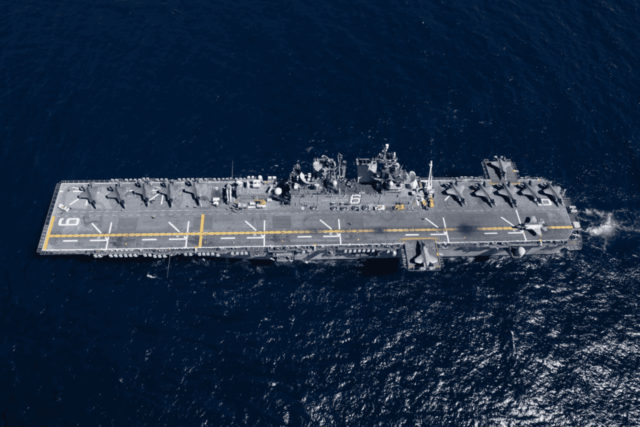
‘Lightning Carrier’ concept shows how Navy, Marine Corps can fly more F-35Bs from amphibs Thirteen U.S. Marine Corps F-35B Lightning II with Marine Fighter Attack Squadron (VMFA) 122, Marine Aircraft Group 13, 3rd Marine Aircraft Wing (MAW), are staged aboard amphibious assault ship USS America (LHA 6). (U.S. Navy photo by Mass Communication Specialist 3rd Class Chad Swysgood)
The Navy and Marine Corps recently proved they can operate an amphibious assault carrier as if it were a fixed-wing aircraft carrier, which officials said will give them more options for how to use these ships in the future.
The naval services fully exercised the Marine Corps’ “lightning carrier” concept for the first time with a record 20 F-35B Lightning IIs operating from the USS Tripoli off the California coast between March 30 and April 8, according to a Marine Corps release Monday. Marine Commandant Gen. David Berger mentioned the concept in his 2019 planning guidance.
The demonstration showed the services can operate amphibious assault carriers with fifth-generation aircraft, like a smaller aircraft carrier, if needed. The exercise had the 20 aircraft operating at a high tempo, the release said. These amphibious assault carriers normally carry a mix of rotary wing aircraft like the MV-22B Osprey helicopters and some F-35Bs, along with several hundred Marines that respond to combat or humanitarian operations as part of a Marine Expeditionary Unit.
“This demonstration proved the versatility of the America-class assault carrier, with its ability to embark either two squadrons of F-35Bs and a [Marine Aircraft Group] command element, or a battalion-sized landing force and the associated assault support [12 MV-22B Ospreys, four CH-53E Super Stallions, and six F-35B Lightning II]. For the fleet commander, both options are formidable and sustainable,” U.S. Navy Capt. Joel Lang, Tripoli’s commander, said in the prepared statement.
The Navy and Marine Corps have been testing out the lightning carrier concept for a few years on the America-class ships, including in 2019 with 13 F-35Bs. A similar “Harrier carrier” concept on the older amphibious assault ships was tried with AV-8B Harriers, the statement said. The lightning carrier concept is not meant to replace how a MEU or an Amphibious Ready Group is assembled, but to show other ways amphibious assault ships can use F-35Bs in the future, according to the statement.
The concept not only gets more F-35s out in the field more quickly, but also makes the amphibious ships more relevant, said Bryan Clark, a naval expert and senior fellow at the Hudson Institute.
“As amphibious assault itself has become a less important mission, you’ve seen over the years, especially over the last decade, how the Marine Corps had to fight to continue to build amphibious ships because the perception is their utility is decreasing,” he said. “So, this is also a way to show how the amphibious assault ship…were versatile and they could do this other mission that was more like an aircraft carrier mission, as opposed to just being ships that carry Marines around and deploy them at the well deck.”
The first two America-class assault carriers were built without a well deck for landing crafts, to make more room for aviation assets; however, the USS Bougainville, which is being built now, will include one.
F-35s can conduct electronic warfare like radar jamming, and they can share data with ships and people on the ground. Having two squadrons of these advanced aircraft on an amphibious assault carrier would give combatant commanders “a multitude of options,” U.S. Marine Lt. Col. Alexander Goodno, the commander of Marine Fighter Attack Squadron 225 said in the prepared statement.
“The fifth-generation capability of the F-35B brings a significant advancement in capability to the combatant commanders, not only as a lethal strike aircraft, but with the vast array of sensors that come with the F-35B’s avionics suite,” he said.
There are several ways the Navy and Marine Corps could use a lightning carrier, especially in the Middle East and in the Pacific. Clark said they could use the concept to deploy to the Middle East with about a dozen F-35Bs and some helicopters to conduct counter terrorism missions—something they have done in the past with Harriers in the Horn of Africa and Yemen.
They can also be used for Expeditionary Advanced Base Operations in the Pacific, he said, where half of the F-35Bs can fly to shore to conduct operations and then fly back to the ship.
Freeing up aircraft carriers is another advantage of the concept, allowing the Navy to focus them on regions like the Indo-Pacific or Europe, Clark said. The amphibious ships could also be used to augment and defend the larger aircraft carriers with air defense, since the F-35B variant does not have the long range of the aircraft carrier’s F-35Cs.
Clark expects the lightning carrier concept to be used in future deployments, particularly in the Pacific, where it could work well for the Japan-based amphibious ready group, which has an additional ship.
“Because there you’ve got four ships in the ARG…and that gives you more space for helicopters and Ospreys,” he said. “So they could easily shift that [America-class assault carrier] to be mostly F-35s, up to 20, every deployment. So I think that’s what we’re likely to see, because that’s what is going to be more useful against the Chinese anyways.”
___
© 2022 Government Executive Media Group LLC Distributed by Tribune Content Agency, LLC




